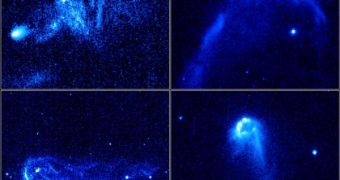A new Hubble study revealed the existence of 14 previously-unknown runaway stars, speeding through the galaxy at enormous velocities for celestial bodies their size. They are followed by a huge trail of gases, which makes them resemble comets at first glance. Astronomers say that their trails are several hundred times the size of our own solar system (measured from the Sun to Neptune), and that, most likely, the stars were “kicked out” from larger clusters by giant forces.
"We think we have found a new class of bright, high-velocity stellar interlopers. Finding these stars is a complete surprise because we were not looking for them. When I first saw the images, I said 'Wow. This is like a bullet speeding through the interstellar medium.' Hubble's sharp 'eye' reveals the structure and shape of these bow shocks," announced NASA astronomer Raghvendra Sahai, working at Jet Propulsion Laboratory (JPL), in Pasadena, California.
Sahai, who was also the leader of the latest Hubble study, says that the stars are not very large in size, a conclusion the researchers came to after noticing that they didn't have glowing clouds of ionized gas, which usually accompany more massive ones. In addition, the shape of the nebula around them is different from the one found around more mature stars, which means that they must only be a few million years old. Their diameter is estimated to be at around a maximum of 8 times that of our Sun.
"The stars in our study are likely the lower-mass and/or lower-speed counterparts to the massive stars with bow shocks detected by IRAS. We think the massive runaway stars observed before were just the tip of the iceberg. The stars seen with Hubble may represent the bulk of the population, both because many more lower-mass stars inhabit the universe than higher-mass stars, and because a much larger number are subject to modest speed kicks," Sahai added.
Experts believe that the stars move at such high speeds because they create a boat-like effect in the dense gas clouds around them, meaning that their emissions are so fast that they collide with the gas and push against it. Scientists now wonder what effect that will have on the clouds themselves, and if agitating them means less chances of a new generation of stars forming.

 14 DAY TRIAL //
14 DAY TRIAL //